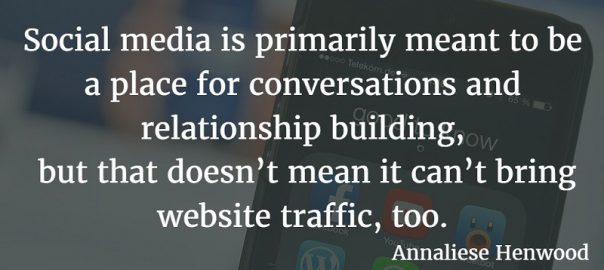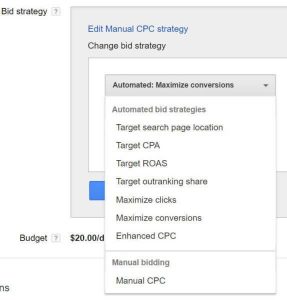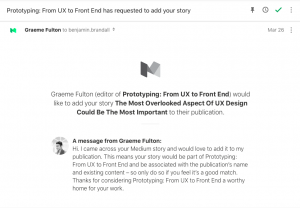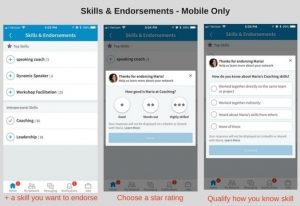You’re on social media because, among other possible reasons, you want to drive visitors to your business website. It’s a good goal, and social media outreach is a handy technique for it. It’s all a matter of how you do it.
Social media is primarily meant to be a place for conversations and relationship building. That’s its main purpose, but that doesn’t mean it can’t bring website traffic, too.

With social media outreach, you can build relationships while also growing interest in your business. You can have conversations and participate in discussions that’ll draw people to your brand. With the right approaches, you can increase website traffic using social media.
— — —
Engage in One-on-One Conversations
Social media is a fantastic place for conversations. When you engage with users one-on-one, you make the conversation more personal and powerful. People appreciate it when brands respond to them directly. This can be done publicly through a tweet or post reply, or you could bring the conversation to private messaging.
Social Media Customer Service Opportunity
Your brand would greatly benefit from using social media outreach as a customer service tool. By responding to complaints (and praise) with a direct reply to the user, you show you care about them and genuinely want to help. It eases tensions and builds your brand image. If you are truly successful, you’ll build brand loyalty from your customer service efforts.
By responding to complaints (and praise) with a direct reply to the user, you show you care about them and genuinely want to help.
Let’s quickly go into three of the initial steps you need to take when starting your social media customer service efforts:
- It’s not required, but you may want to create a separate account on Twitter for customer service activity. For example, I once reached out to Barnes & Noble for assistance, and their customer service handle took over to assist me. When you have a separate handle, you’re better able to filter through the noise and respond faster.
- You’ll want to hire a committed and professional social customer support team. These individuals should know how to respond to complaints (and praise) in a quick, appropriate, and effective manner. A great way to humanize your customer support efforts is to have the team members sign each response with their name at the end.
- You should definitely have established guidelines for your customer service activity. This official document should clearly define your support tone for each social media platform that you use for customer service. How you communicate on Twitter will be different from how you respond on Instagram or Facebook because of character limits. You’ll also want to have premade answers to frequently asked questions. There’s no need to waste time creating these answers repeatedly at each moment. You’ll want these elements of a guidelines system and any other important procedures ready to go for your support team.
Brand and Keyword Monitoring Strategies and Tools
When you want to engage with users directly, you need to know how to do it effectively. This means you need to know how to monitor everything. You’ll want to know what keywords you’ll monitor and what tools to use to monitor them along with brand mentions.
Monitoring Tools
These are the few tools that I highly recommend for monitoring your company and keyword mentions:
“Increase brand awareness, improve your reputation, and make valuable relationships on social media.”
- Allows you to see who’s talking about you and gives you the opportunity to respond from within the tool
- Offers mobile apps for monitoring on the go
- Includes team collaboration
- Provides in-depth analytics and reports of what’s working along with market research
Pricing: request demo
“Understand the conversations happening around your brand with our real-time social analytics solution.”
- Offers a social sentiment measurement
- Is not limited to only social media platforms (over 100 million sources)
- Provides real-time analytics and reports
- Allows you to set alerts to be notified of unusual activity
Pricing: custom
- Track hashtags, account handle mentions, keywords, other handle mentions, and URLs
- Real-time analytics dashboard
- Influence measurement lets you know the most important mention sources
- Easy-to-share social reports using a link or downloading as a PDF
Pricing: list of plans
“Know what customers think. Discover vital insights within the billions of conversations happening online every day. Be the first to act on the next big opportunity in your market.”
- Includes customer insights
- Offers alerts to stay ahead of the game
- Gives you in-depth analytics and reports
Pricing: request demo
“Track social activity across multiple networks and profiles in a unified social inbox…”
- The smart inbox includes one place for all your activity, filters to better monitor and respond, and custom tags for organization.
- Works with Twitter and Instagram
- Monitor hashtags, keywords, and influential users (Twitter)
Pricing: list of plans
Monitoring Strategies
Which keywords matter? Let’s list a few that you should consider monitoring:
- Company name
- Competition names
- Product names
- Influencers
- Your CEO’s name
- Industry buzzwords
Find the keywords that matter most to your marketing campaigns and goals. Then, choose a tool that’ll help you monitor them. Be active and responsive when the opportunities arise, and you’ll see people build interest in your business.
Although social customer support and monitoring aren’t direct way to drive traffic to your website, they are great ways to indirectly do so. People who hear from you at a good time and way will be more likely to visit your website because you’ve left a positive impact on them. If they’re existing customers, they might want to visit your website to buy from you again. If they are prospects, they may visit your website with enhanced curiosity.
People who hear from you at a good time and way will be more likely to visit your website because you’ve left a positive impact on them.
Social customer service and monitoring are great outreach tactics, and they’re worth your investment if you want to see long-term business success. They lead to brand loyalty and advocacy, which are both key to maintaining a healthy sales cycle.
Provide Free or Discounted Offers
Offers are a highly-effective way of driving social media traffic to your website – when you promote them effectively. It’s one thing to have an awesome offer, but if you aren’t promoting it to the right audience in the right way and at the right time, you won’t get the traffic you want.

How do you promote your offer?
Let’s say you have a new eBook about email marketing. It’s gated behind an optimized landing page, and you’re ready to promote it on social media. What do you do?
- You need to know who you’re targeting with your eBook. You need to know your target audience. If you’re just sharing updates randomly and generically, you won’t be successful in reaching your target audience. People want to see you speak to them as individuals, so you should have social updates that are focused on their needs.
- You need to know when to promote your new eBook. If your target audience is on the East Coast time zone, you don’t want to share an update when they’re asleep. There are many studies about the best times to post to social media, but it’s more important that you know who you’re targeting and when they are online. Generic studies are a helpful start, but you have your own unique audience to research.
- You need to know how you’ll promote your offer. On Facebook, organic reach is almost nonexistent, so you might want to consider advertising there. On other platforms, you might achieve better organic results by simply publishing updates at the right time to your target audience. Paid social promotion can either be cost effective or an expensive mistake. You should start by focusing on organic promotion and see if it’s effective. Advertising is a good secondary option if organic isn’t working.
What else is needed to drive traffic from an offer?
Your offer could be absolutely amazing. It could be out of this world, but if your social media copy isn’t persuasive, no one will care. Your social media updates should always include a clear, actionable call-to-action to get people’s attention. With optimized CTAs, you’ll see more people click through to your offer’s landing page.
Be persuasive and explain the benefits of your offer. Tell people why it’s worth their time to click through. That’s why it’s so important to target the right audience. When you know your target audience, you’re able to create CTAs that appeal to them.
Promote Blog Content
This is perhaps the most common way to drive website traffic from social media. If you have an active blog (you really should), promoting it on social media is one of the best ways to get people to visit it. Every time you publish a blog post, you should be ready to promote it heavily on social media. Content promotion is going to take more of your time than the creation work itself, so you want to know the best practices to truly make the most of it.
If you have an active blog (you really should), promoting it on social media is one of the best ways to get people to visit it.
Blog Content Promotion Best Practices
- Do the necessary research on your audience and their needs. That way you can create social media updates that cater to them.
- Make sure you’re using the right hashtags and keywords. Researching before posting is key. Use RiteTag to get instant feedback on the right hashtags for your content.
- Mention those users you included in your content. Influencers you cited could potentially share your post to their audiences and thus grow your reach.
- Don’t spam your followers. Tweet bursts are annoying and will push people to unfollow you. LinkedIn groups don’t tolerate overly aggressive self-promotion, and you can get kicked out. Space out your tweets, and only share in groups when your content is relevant and helpful.
Blogging for Lead Generation
Congrats! You got your social media audience’s attention, and they’ve clicked through to your blog post. What else is important to do?
Your blog should always have a relevant, valuable call-to-action that helps you convert visitors into leads. You don’t want to require visitors to surf through your website or even visit a contact us page when they land on your blog content. Put the form right there for them to fill out. Blogging is supposed to be about educating and helping people, but it can also be a way to collect leads for your business.
— — —
Even though only three were mentioned here, you have many options for driving website traffic from social media. These are just quick mentions of four other ways…
Run a social media contest.
Impact Branding & Design has a blog article that gives you everything you need to know to create a contest that works. Contests are engaging and fun, and your audience will appreciate your efforts. You can even use these contests for more than just engagement. You can collect user-generated content (UGC) and highlight the best from your account. The more engaging your contest is, the more likely you’ll increase website traffic.
Announce events.
Eventbrite created an eBook guide to using social media for event promotion. It’s a great guide for anyone who wants to know the best places and ways to promote their event. Social media platforms, especially Facebook, make event promotion easy and effective. You can target the audience you want to attract and give them all the information they need. Once you’ve convinced them, you can give them the link to the event on your website.
Participate in Twitter chats.
If you want to build relationships on social media that last, Twitter chats are the way. You can use these chats to not only grow a following but also improve brand image and influence. Whether you choose to host a chat or just participate, your brand can benefit from it. Even though this isn’t a direct way to drive website traffic, you can still get people to visit indirectly. If you’re hosting the chat, create a webpage dedicated to chat information and recaps. Include plenty of opportunities for visitors to convert there. If you’re only participating as a guest, share valuable input that other participants will appreciate. Don’t share links unless they fit well with the conversation.
Share thought leadership pieces on LinkedIn.
If possible, get your CEO to share your best blog content or, better yet, original content from his or her LinkedIn profile. If the content fits well with a LinkedIn category, it might get featured. This will dramatically increase your readership and engagement. That’s why you need to make sure every content piece has a clear, compelling call-to-action to bring readers to your own website. LinkedIn Pulse offers many opportunities to drive website traffic.
— — —
When you’re ready to engage on social media, don’t push the website traffic idea. Traffic will come naturally when you use social media for what it’s meant for: conversations and relationship building. People will click through to your website when you engage and share value. Being overly self-promotional and sales-y won’t work. It’ll hurt your brand image and push people away.
Use social media as it’s meant to be used, and you’ll see the right visitors come rolling in.
Digital & Social Articles on Business 2 Community(44)








